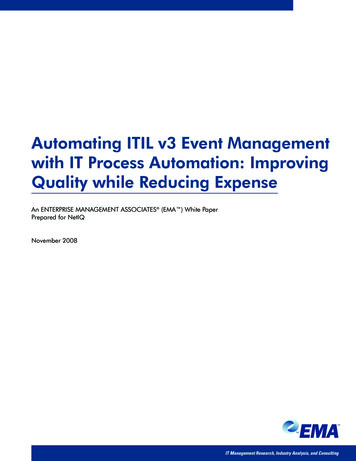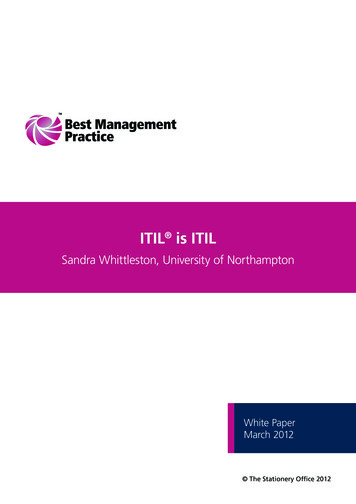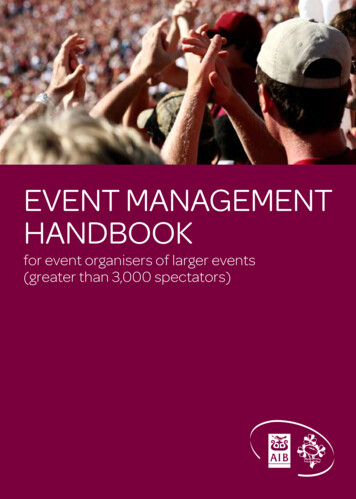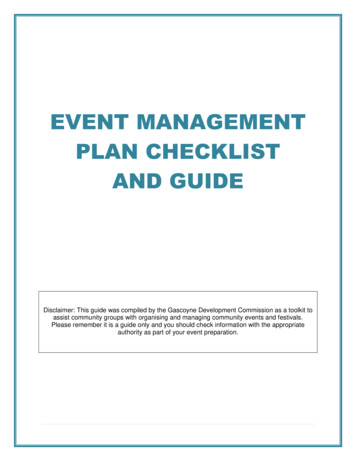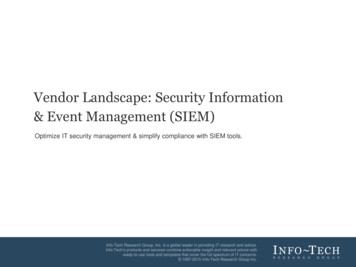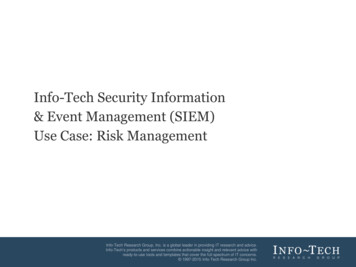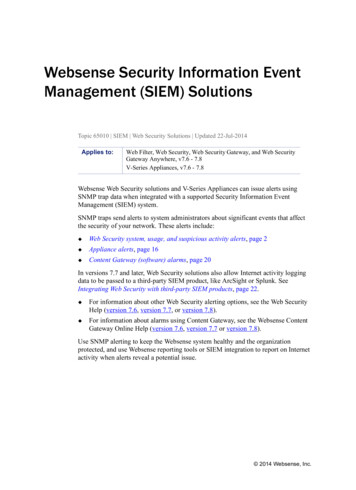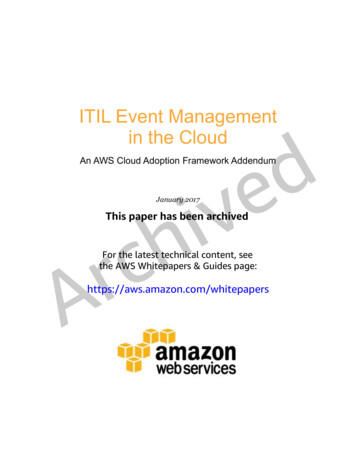
Transcription
ITIL Event Managementin the ClouddeAn AWS Cloud Adoption Framework AddendumvihJanuary 2017This paper has been archivedcrAFor the latest technical content, seethe AWS Whitepapers & Guides page:https://aws.amazon.com/whitepapers
2017, Amazon Web Services, Inc. or its affiliates. All rights reserved.NoticesThis document is provided for informational purposes only. It represents AWS’scurrent product offerings and practices as of the date of issue of this document,which are subject to change without notice. Customers are responsible formaking their own independent assessment of the information in this documentand any use of AWS’s products or services, each of which is provided “as is”without warranty of any kind, whether express or implied. This document doesnot create any warranties, representations, contractual commitments, conditionsor assurances from AWS, its affiliates, suppliers or licensors. The responsibilitiesand liabilities of AWS to its customers are controlled by AWS agreements, andthis document is not part of, nor does it modify, any agreement between AWSand its customers.crAvihde
ContentsIntroduction1What is ITIL?1What is the AWS Cloud Adoption Framework?2Event Management in ITIL3Event Management and the CAF5deCloud-Specific Event Management Best Practices for IT Service Managers5Cloud Event Monitoring, Detection, and Communication Using AmazonCloudWatch6vihConclusionContributorscrA1111
AbstractMany enterprises have successfully migrated some of their on-premises ITworkloads to the cloud. An enterprise must also deploy an IT ServiceManagement (ITSM) framework so it can efficiently and effectively operate thoseIT capabilities. This whitepaper outlines best practices for event management ina hybrid cloud environment using Amazon Web Services (AWS).crAvihde
Amazon Web Services – ITIL Event Management in the CloudIntroductionThis whitepaper is for IT Service Management (ITSM) professionals who supporta hybrid cloud environment that uses AWS. The focus is on Event Management, acore chapter of the Service Operations volume of the IT Infrastructure Library(ITIL). Many AWS enterprise customers have successfully integrated their cloudstrategy with their ITIL-based IT service management practices. This whitepaperprovides you with background in the following areas: Event Management in ITIL The AWS Cloud Adoption Framework Cloud-Specific Event Management Best PracticesdevihWhat is ITIL?The IT Infrastructure Library (ITIL) Framework, managed by AXELOS Limited,defines a commonly used, best-practice approach to IT Service Management(ITSM). It builds on ISO/IEC 20000, which provides a “formal and universalstandard for organizations seeking to have their ITSM capabilities audited andcertified.”1 However, the ITIL Framework goes one step further to proposeoperational processes required to deliver the standard.crAITIL is composed of five volumes that describe the entire ITSM lifecycle asdefined by the AXELOS. To explore these volumes in detail, go tohttps://www.axelos.com/.The following table gives you a brief synopsis of each of the five volumes:ITIL VolumeDescriptionService StrategyDescribes how to design, develop and implement servicemanagement as a strategic assetService DesignDescribes how to design and develop services and servicemanagement processesService TransitionDescribes the development and improvement of capabilities fortransitioning new and changed services into operationsService OperationEmbodies practices in the management of service operationContinual Service ImprovementGuidance in creating and maintaining value for customersPage 1
Amazon Web Services – ITIL Event Management in the CloudWhat is the AWS Cloud Adoption Framework?The Cloud Adoption Framework (CAF) offers comprehensive guidelines forestablishing, developing, and running cloud-based IT capabilities. AWS uses theCAF to help enterprises modernize their ITSM practices so that they can takeadvantage of the agility, security, and cost benefits afforded by the cloud.Like ITIL, the CAF organizes and describes the activities and processes involvedin planning, creating, managing, and supporting a modern IT service. ITIL andthe CAF are compatible. In fact, the CAF provides enterprises with practicaloperational advice for how to implement and operate ITSM in a cloud-based ITinfrastructure.devihThe details of the AWS CAF are beyond the scope of this whitepaper, but if youwant to learn more, you can read the CAF whitepaper athttp://d0.awsstatic.com/whitepapers/aws cloud adoption framework.pdf.The CAF examines IT management in the cloud from seven core perspectives, asshown in the following table:crACAF PerspectiveDescriptionPeopleSelecting and training IT personnel with appropriate skills, defining andempowering delivery teams with accountabilities and service level agreementsProcessManaging programs and projects to be on time, on target, and within budget, whilekeeping risks at acceptable levelsSecurityApplying a comprehensive and rigorous method of describing a structure andbehavior for an organization’s security processes, systems and personnelStrategy & ValueIdentifying, analyzing, and measuring the effectiveness of IT investments thatgenerate the most optimal business valueMaturityAnalyzing, defining, and anticipating demand for and acceptance of envisioned ITcapabilities and servicesPlatformDefining and describing core architectural principles, standards, and patterns thatare required for optimal IT capabilities and servicesOperationTransitioning, operating, and optimizing the hybrid IT environment, enablingefficient and automated IT service managementPage 2
Amazon Web Services – ITIL Event Management in the CloudEvent Management in ITILThe ITIL specification defines an event as “any detectable or discernableoccurrence that has significance for the management of the IT infrastructure orthe delivery of IT service.” In other words, an event is something that happens toan IT system that has business impact.An occurrence can be anything that has material impact on the business such asenvironmental conditions, security intrusions, warnings, errors, triggers, or evennormal functioning. Occurrences are things that an enterprise needs to monitor,preferably in an automated fashion, giving you the visibility you need to run yoursystems more efficiently and effectively over time with minimal downtime.vihdeThe goal of Event Management is to detect events, prioritize and categorize them,and figure out what to do about them.In practice, Event Management is used with a central monitoring tool, whichregisters events from services or other tools such as configuration tools,availability and capacity management tools, or specialized monitoring tools.Event Management acts as an umbrella function that sits on top of other ITILprocesses such as Incident Management, Change Management, ProblemManagement, or Service-Level Management and divides the work depending onthe type of event or its severity.crAAXELOS provides the following flow chart to describe what an enterprise’s EventManagement process should look like:Page 3
Amazon Web Services – ITIL Event Management in the ClouddevihcrAFigure 1: Event management in ITILAXELOS observes that not all events are, or need to be, detected or registered.Defining the events to be managed is an explicit and important managementdecision. After management decides which events are relevant, servicecomponents must be able to publish the events or the events must be pollable bya monitoring tool. Events must also be actionable. The Event Managementprocess, whether automated or manual, must be able to determine what to do forany event. This determination can take many forms such as ignoring, logging, orescalating the event. Finally, the Event Management process must be able toreview and eventually close events.Page 4
Amazon Web Services – ITIL Event Management in the CloudEvent Management and the CAFAs with most specifications covered in the Service Operation Volume of ITIL,Event Management falls nicely into the Cloud Service Management function ofthe AWS CAF Operating Domain.Of course, cloud initiatives require more than just the right technology. They alsomust be supported by organizational changes, including people and processchanges. Such changes should be supported by a Cloud Governance Forum orCenter of Excellence that has the role of managing through transition using theCAF. From the perspective of ITSM, your operations should certainly have a seatat the table.devihFigure 2 illustrates how the CAF looks at managing events and actions in a hybridenvironment. Review and action is based on information comes from the onpremises environment or any number of cloud providers (private or public).crAFigure 2: CAF integrationCloud-Specific Event Management BestPractices for IT Service ManagersAWS provides the building blocks for your enterprise to create your own EventManagement Infrastructure. These building blocks allow for the integration ofcloud services with on-premises or more traditional environments. In particular,Page 5
Amazon Web Services – ITIL Event Management in the CloudAWS provides full support for ITIL Section 4.1.10: Designing for EventManagement. AWS does not provide Event Management as a Service. Enterprisesthat enable Event Management would need to deploy and manage their ownEvent Management infrastructure.Cloud Event Monitoring, Detection, andCommunication Using Amazon CloudWatchAWS supports instrumentation by providing tools to publish and poll events. Inparticular, you can use the Amazon CloudWatch API for automated managementand integration into your Event Management infrastructure.deAmazon CloudWatch monitors your AWS resources and the applications that yourun on AWS in real-time.2 You can use Amazon CloudWatch to collect and trackmetrics, which are the variables you want to measure for your resources andapplications. In addition, Amazon CloudWatch alarms (or monitoring scripts)can send notifications or automatically make changes to the resources that youare monitoring based on rules that you define. For information on CloudWatchpricing go to the Amazon CloudWatch pricing page.3vihcrAYou can use CloudWatch to monitor the CPU usage and disk reads and writes ofyour Amazon Elastic Compute Cloud (Amazon EC2) instances. Then you can usethis data to determine whether you should launch additional instances to handleincreased load. You can also use this data to stop under-used instances and savemoney.In addition to monitoring the built-in metrics that come with AWS, you canmonitor your own custom metrics. You can publish and monitor metrics that youderive from your applications to reflect your business needs. With AmazonCloudWatch, you gain system-wide visibility into resource utilization, applicationperformance, and operational health.4Amazon EC2 Monitoring DetailRead more about Amazon EC2 monitoring in the AWS documentation:http://docs.aws.amazon.co m/AWSEC2/latest/UserGui de/monitoring ec2.htmlPage 6
Amazon Web Services – ITIL Event Management in the CloudBy default, metrics and calculated statistics are presented graphically in theAmazon CloudWatch console. You can also retrieve these metrics using the APIor command line tools. When you use Auto Scaling, you can configure alarmactions to stop, start, or terminate an Amazon EC2 instance when certain criteriaare met. In addition, you can create alarms that initiate Auto Scaling and AmazonSimple Notification Service (Amazon SNS) actions on your behalf.5An enterprise that does not have its own event management infrastructure canimplement basic ITIL Event Management using Amazon CloudWatch. However,most large enterprises, especially those running hybrid cloud designs, willmaintain their own event management infrastructure using products such asBMC Remedy, Microsoft System Center, or HP Open View.deMany event management tools are integrated with Amazon Web Services. See thefollowing table for some examples.vihToolReferenceMS enter/BMC Remedyhttp://media.cms.bmc.com/documents/439126 BMC Managing AWS SWPcrA.pdfIBM MEK0CA W/ref portal asin urlToolReferenceCA Nimsofthttp://www.ca.com/ /media/Files/DataSheets/ca-nimsoft-monitor-for- amazonweb-services.pdfHP WTPmSzTYThis type of design is fully compatible with AWS. However, enterprises will needto deploy SNMP, AWS SNS, or other interfaces that sit between AmazonCloudWatch and their enterprise Event Management / Service Desk tool. ThisPage 7
Amazon Web Services – ITIL Event Management in the Cloudwill ensure that AWS-generated events can pass through Amazon CloudWatchand into the enterprise Event Manager.IT service management professionals who integrate Amazon CloudWatch intotheir enterprise event management infrastructure need to answer the followingquestions: Are the right events are being propagated? Are the events tracked at the right level of granularity? Is there a mechanism to review and update triggers, limits, and eventhandling rules?Best Practices for Monitoring in AWSdevihMake monitoring a priority to head off small problems before they become bigones.Automate monitoring tasks as much as possible.crACheck the log files on your services (Amazon EC2, Amazon S3, Amazon RDS,etc.).Create and implement a monitoring plan that collects data from all parts of yourAWS solution so that you can more easily debug a multi-point failure, if oneoccurs. Your monitoring plan should address, at a minimum, the followingquestions: What are your monitoring goals? What resources will you monitor? How often will you will monitor these resources? What monitoring tools will you use? Who will perform the monitoring tasks? Who should receive notification when something goes wrong?Page 8
Amazon Web Services – ITIL Event Management in the CloudIncident ManagementEvents classified as Warnings or Exceptions may trigger incident managementprocesses. These processes restore normal service operation as quickly aspossible and minimize any adverse impact on business operations.In the ITIL process, first attempt to resolve warnings or exceptions by consultinga database of known errors or a configuration management database (CMDB). Ifthe warning or exception is not in the database, then classify the incident andtransfer it to Incident Management. Incident Management typically consists offirst line support specialists who can resolve most of the common incidents.deWhen they cannot resolve an incident, they escalate it to the second line supportteam, and the process continues until the incident is resolved. IncidentManagement tries to find a quick resolution to the Incident so that the servicedegradation or downtime is minimized.”1vihcrAFigure 3: Incident management in ITILIt is worth noting that a well-designed cloud infrastructure can be far moreresilient to faults. There is less likelihood of generating production incidentswhere faults are able to gracefully fail over. Underlying problems can be resolvedthrough Problem Management.Page 9
Amazon Web Services – ITIL Event Management in the CloudIncident Management Best PracticesAs part of cloud-integrated Incident Management, enterprises should defineseveral parameters: Ensure that relevant employees and staff understand which services areAWS-operated versus enterprise-operated (for example, an Amazon EC2instance versus a business application running on that instance). Ensure that relevant staff and processes are aware of the SLAs associatedwith AWS-operated services and integrate those SLAs into the existingEnterprise Incident Management infrastructure. Define explicit SLAs (including resolution time scales) for servicesoperated by the enterprise, but running on the AWS infrastructure. Define Incident Severity levels and Priorities for all services running onthe AWS infrastructure. Subscribe to Enterprise Support and agree on the role the AmazonTechnical Account Manager (TAM) will have during Incident Responses.For example, for Severity 1 incidents, should the TAM be part of theemergency resolution bridge / emergency response team?devihcrA Ensure 360 degree ticket integration. Make sure that ticket opening andclosing is seamless across on-premises and cloud systems. Define recovery runbook recipes (Incident Model) that include therecovery steps in chronological order, individual responsibilities,escalation rules, timescales and SLA thresholds, media/communicationsroles, and post- mortems. You should note that in a cloud environment,where infrastructure is defined as code, termination and reboot might bea faster way to recover from an incident than by using standard debuggingapproaches. Service can be immediately restored and root problems canbe addressed offline as part of Problem Management. Where possible, incident remediation should occur automatically, with nohuman intervention. However, where human intervention is required,that intervention should be simple, with mostly automated runbook steps.Problem ManagementProblem Management is the process of managing the lifecycle of all problemswith the goal of preventing repeat incidents. Whereas the goal of IncidentManagement is to recover, Problem Management is about resolving root causesPage 10
Amazon Web Services – ITIL Event Management in the Cloudso that incidents do not recur and maintaining information about problems andrelated solutions so organizations can reduce the impact of incidents.Enterprises operating a hybrid environment will likely have their own ProblemManagement infrastructure. The goal of integration should be to seamlesslyintegrate the process for addressing problems related to AWS into the existingProblem Management infrastructure.Enterprises have the option of purchasing AWS Enterprise Support, where theycan agree on role the Amazon Technical Account Manager (TAM) will haveduring Problem Management. For example, where the problem explicitly involvespart of the AWS infrastructure, the TAM might be involved with formal problemdetection, prioritization, and diagnosis workshops and discussions or be requiredto log AWS-related problems with the enterprise Problem Logging platform /Known Error Database.devihIf AWS infrastructure is not part of the root cause, it could play a role insupporting diagnosis. Here the TAM can support the information gathering.crAConclusionEnterprises that migrate to the cloud can feel confident that their existinginvestments in ITIL, and particularly Event Management, can be leveraged goingforward. The Cloud Operating model is consistent with traditional IT ServiceManagement discipline. This whitepaper gives you a proposed suite of bestpractices to help smooth the transition and ensure continuing compliance.ContributorsThe following individual contributed to this document: Eric Tachibana, AWS Professional ServicesNotes1ITIL Service Operation Publication, Office of Government Commerce, 2007,Page 52For up to 2 weeks!Page 11
Amazon Web Services – ITIL Event Management in the at Is Amazon 5For more information about creating CloudWatch alarms, see Creating AmazonCloudWatch Alarms in the CloudWatch html).vihdecrAPage 12
a hybrid cloud environment that uses AWS. The focus is on Event Management, a core chapter of the Service Operations volume of the IT Infrastructure Library (ITIL). Many AWS enterprise customers have successfully integrated their

